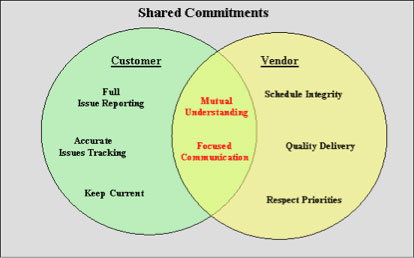Good User / Vendor Relationships – An Oxymoron? It doesn’t have to be that way
Can software vendors and their customers get along? Most think not. This perception is so common that it is taken to be the industry standard, and thus becomes a self-fulfilling prophecy on many projects. End users assume that nothing beyond a cordial, yet distant relationship could ever be achieved and often simply dismiss the possibly of anything more right from the start. I believe this to be both untrue and dangerous; to customers and vendors alike.
Perhaps the better question is: Can software vendors and customers afford not to get along? If you and your company don’t have a productive relationship with your software provider, then it is likely you are not receiving the maximum benefits from your software. And if this software is running any key part of your operation (as most applications are), this means that you are not operating your business as efficiently as possible. This ultimately will cost you – dollars and lost opportunity.
Why Does It Matter Anyway?
Aside from the opportunity costs associated with failing to fully utilize your application software “dysfunctional” vendor-customer relationships often have other, less obvious, but potentially more damaging impacts.
In general, the weaker your relationship, the less likely it is you will resolve issues in a timely fashion. This can lead to a vicious circle worsening matters as time goes by. As the customer’s frustration begins to grow, the patience, courtesy and respect they show the vendor’s support team will begin to abate. The vendor, in turn, will eventually become less and less likely to assist these increasingly agitated users with the same spirit, enthusiasm and comprehensiveness as those customers with whom they share a better relationship. This of course increases the issue resolution period, adding to the user’s inconvenience and, thus adding to the frustration.
It is important that the customer’s project sponsor and vendor’s project managers work very hard to avoid this deadly downward spiral. If this condition persists for any significant period of time it can lead to a subtle and often irreversible lessening of the end user’s confidence – not only in the vendor and their software but in the sponsoring organization within the customer (e.g. IT, operations, etc.). In my experience this can be deadly for a business. If users don’t believe in the system, it is very unlikely that it will succeed. And if it doesn’t – usually the chief sponsor for these projects doesn’t either.
The vendor is similarly impacted. First and likely most important to the long term health of the organization, they will suffer in the marketplace due to a less than satisfied customer. There is nothing more hazardous to a software salesperson than unhappy users – they have friends in the industry and they talk.
Moreover, the stress and frustration resulting from these difficult relationships can, if persistent, lead to noticeably reduced morale within the vendor support team and potentially throughout the entire organization. Of course in the long term, this will leaded in reduce productivity and increased costs; both bad for business.
How did we end up here?
There are a wide number of explanations for the condition in which almost literally the entire business software industry and their customers find themselves. However, I believe each of these ultimately can be traced back to one large and fundamental failing in the early development of the business relationship between the two organizations. Customers usually don’t have a significant amount of experience dealing with software companies – organizations which rarely function like other suppliers with whom they are more accustomed to dealing. In contrast, software vendors often don’t do a great job of defining their needs – particularly during the period following the commencement of the implementation.
Obviously the ideal to time to gain this understanding is at outset of the relationship. However during the “honeymoon period” when there are no problems most vendors are fearful that even the hint of future difficulties could scuttle the contact. Over the years customer implementation expectations have become more realistic, however discussions related to unforeseen issues still seems to be very taboo.
Ironically, it is during this early period when the individual relationships are usually at their peak and thus it is the most conducive time to make the commitments and develop the corresponding procedures necessary so that the relationship may function properly during the more trying periods sure to follow.
This honeymoon almost always ends (usually fairly abruptly) early in the implementation upon the appearance of the first bumps in the road. Be it either a new requirement surfacing, a previously promised function failing to materialize or simply a slip in the agreed schedule, something will cause the two sides to begin to retreat to their respective corners and start dealing with each other from a defensive posture. In my experience, rarely do organizations recover from this and return to a more open and effective partnership.
How Do We Avoid All This Pain?
I believe that these relationships are not lost and can be returned to a state in which both organizations are able to function much closer to the ideal. Of course, if you are just beginning your relationship you are in an enviable position. By applying my recommendations from the start you can create your relationship properly and avoid a great deal of trouble and frustration later in the process.
How can this be accomplished? Well, as in any relationship, both parties share responsibility for its proper functioning. Each party must make a number of commitments, the first and most important: Seek to understand each other
Boiled down to its bare essence, these relationships work if the two sides agree that a customer’s job is to make it easy to be supported and as vendors it is your job to make it quick and easy to get that support. This may sound trite, but it is amazing how often the importance of these roles is simply not appreciated. It just makes sense though given basic human nature. We all want to work with people who we like and with whom we feel it is easy to deal – rather than the alternative. It is a real life example of the old saying that you can “catch more flies with honey than vinegar” and I believe it very appropriate in this context.
Commitments – To Make & Keep
To properly begin a new relationship, or return an existing one to a more constructive footing, each party must make the following series of commitments to each other and develop the corresponding procedures to support those commitments:
Both: Single point of contacts
Effective communication between the two parties is a very large component of a properly functioning relationship. As a customer, it is important that you present a consistent “face”, in the form of a dedicated internal support person, to your vendor. This person will develop a relationship with the vendor’s support representative and over time this will yield a much more effective and efficient support process for both parties. From the user’s perspective it is important to note that this person need not be the source of issues nor posses the most knowledge of the software, but rather will serve as the conduit between the affected users and the vendor.
The vendor will benefit as they will have one person to interact with when researching issues. This will save them a tremendous amount of time in locating the appropriate user, describing their research requirements and educating multiple users on the various support procedures.
Over time these two parties will develop a sense of trust and respect for each other. Very quickly, the vendor will reach a point where it will no longer be necessary to repeat the same simple and standard resolution procedures because he or she will know those have been eliminated before reporting the issue. Conversely, the user will know he or she does not need to feel defensive about the validity of the issue, nor waste time answering foolish vendor questions designed to eliminate the obvious. This sort of relationship will eventually become a tremendous time saver for both parties.
Therefore, both organizations should formally assign a primary (and possibly a secondary) person to this role and share this and all relevant contact data with each other.
Customers: Report Issues Completely & Truthfully
Every software company I have ever dealt with has a preferred method they would like to use to support their customers. As their customer, why not make it as easy as possible for them to properly support you? Why not create or adjust your issues reporting process to match their requirements?
Is it really fair to submit issues with a five word description delivered via voice mail? In most cases it actually causes more work on the customer’s end to do it incorrectly, given that it is likely that you will eventually have to collect and report all the required data anyway. Collecting and reporting in pieces rather than completely from the start will certainly require more time in the long run.
Further, you should try to assign real priority codes to issues. By definition, not everything can be critical or top priority. If you assign a high priority to each and every issue submitted, eventually you will encounter a truly serious problem and will find that it doesn’t get the response that you believe it should (the story of the boy who cried “wolf” ring a bell?).
Thus, as a vendor you should inform your customers of the method, format and information you require for your issues management system. Similarly, as a customer, you should develop a standard issues reporting template (conforming to the vendor’s requirements) and an associated priority assignment methodology.
Vendors: Live Up to Your Promises
Acknowledge that customers are making important business decisions based upon your commitments. Before you promise a fix or release for a specific date, make 100% sure that this is in fact a promise that you can keep. No one expects perfection, but variations to a published schedule should be very rare and when they do occur should be communicated to customers as early as possible out of respect for their planning needs.
Customers: Develop, Maintain & Communicate a Real List of Issues
Instead of simply shaking your head and referring to “all the issues” with your software, make a list. More often than not when I work with companies making such statements their vendors are unaware of 90% of the perceived issues. In all fairness – they can’t fix that which they don’t know about! Perhaps you thought you reported it, but if it was mentioned in passing to your account representative, that doesn’t mean the issue made it to their support database.
Also, when an issue originally thought to be a software problem, turns not to be caused by your vendor’s programs (i.e. data, hardware or perhaps operational) update your partner and remove it from your issues list or reclassify it. It is not fair to ask them to find and correct something that is no longer an issue. Nor does it do you any good to have their resources investigating a non-issue when they could be working on a real one.
Finally, be sure to report and track only valid and repeatable problems – don’t ask them to chase ghosts or transient issues. I understand that these are often the most frustrating, but chances are very high that if you can’t make it happen neither can they. Having said that, there are some instances where it is very reasonable to ask them to help with something you can’t replicate. If this issue is causing your operation pain, you are certain it has happened numerous times and you have spent a significant amount of time attempting to duplicate it yourself, then and only then it is fair to ask your vendor for assistance. At a minimum they should be able to help you brainstorm about the potential source of the problem.
To meet this commitment, as a customer you should develop your own issues tracking and communication system. Further, both organizations should work together to define a regular conference call schedule to review all currently outstanding issues.
Vendors: Deliver Quality
There is nothing that can cause your relationship to return to a defensive and hostile posture more quickly than new code which breaks more than it fixes or otherwise significantly impacts business operations. No one is saying that software fixes should be 100% defect free, but certainly the customers should not function as your test lab. It is important that you test new code in an environment similar to that of your customer, ideally using an exact copy of your customer’s environment and data.
Furthermore, your fix and release installation procedures should always include a recovery path enabling the customer to easily remove new, but problem causing software and return to the previous installed version.
Customers: Stay Current
I believe that it is goes without saying that if you are running the most current version of your vendor’s software it is much easier for them to support you. However, in the real world this is not always possible. If you receive a new release which you feel will jeopardize your business either by removing a necessary piece of functionality or risking operations due to quality concerns, then it is both acceptable and in fact very prudent to delay the installation.
In most cases though, you should strive to stay as up to date on your software as possible. This means installing patches and releases, after internal testing in most cases, within a reasonable time period. For most vendors this means within 2 to 6 months of release.
This is not to say you should rush installation either. In fact, the savviest users will delay a significant portion of the allowable period, offering other customers the opportunity to find any defects!
Parallel to your upgrade policy should be a commitment to keep up to date on your knowledge of that software. New releases often contain additions or changes to functionality. Strive to understand what you have received and integrate it into your business processes as appropriate. Also, if your vendor offers training, send a staff member or two every year to update and refresh their knowledge. If you don’t, chances are you are underutilizing your software investment.
Vendors: Respect Your Customer’s Priorities
If you are asking customers to assign relative priority to issues, then strive to address them in the requested sequence. There are circumstances where corrections will arrive out of sequence, but that should be the exception and not the rule. Just because something is easier to fix or appears more serious, doesn’t necessarily mean that you should address it before an item your customer has given a higher priority.
Can It Really Be Fixed?
Yes, it can. As a matter of fact, we at Argon & Co have had numerous successful engagements where we have done just this.
By serving both the vendor and the customer as something of a mediator, helping to re-establish trust, providing an independent ruling on what is an unreasonable expectation vs. poor service, and developing and installing ongoing operating procedures, we have been able to successfully help to drive organizations towards finishing these projects and moving the relationship to a solid footing that will serve them both greatly in the years to come.
If the introductory paragraphs sound a little too familiar, you and your organization could definitely benefit from the application of the guidance detailed here. We have found that an experienced and unbiased outside party is the most effective and sometimes the only method to do that and to ultimately recover these failed relationships.
It Takes Work, But…
Sounds simple right? No, of course not but no relationship ever is nor necessarily should be. Making and keeping the commitments described here will reward you both with an effective, efficient, productive and profitable Customer-Vendor relationship – yielding benefits far greater than the time and effort expended creating and maintaining it.
As of September 8, 2020, Crimson & Co (formerly The Progress Group/TPG) has rebranded as Argon & Co following the successful merger with Argon Consulting in April 2018.








